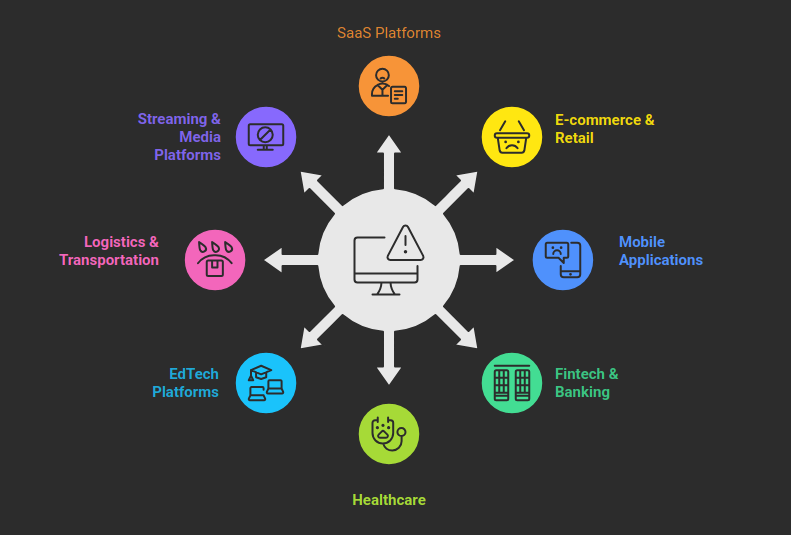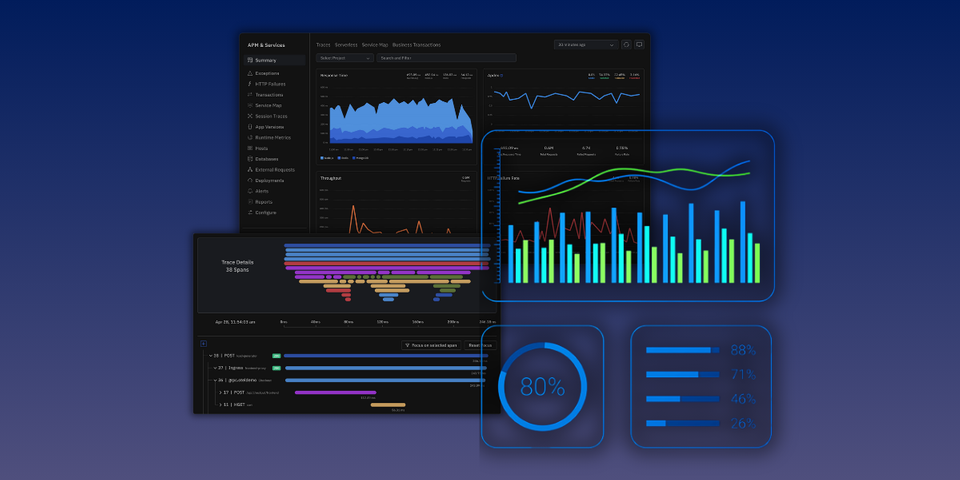The Hidden Cost of Not Using APM in Production
Many organizations don’t realize how important it is to monitor how their applications run in production. Without Application Performance Monitoring (APM), it becomes difficult to detect and resolve issues quickly, leading to increased downtime, wasted developer effort, and poor user experience.
These hidden costs, though not always visible at first, can impact customer satisfaction, reduce team efficiency, and result in lost revenue. This article explores how the absence of APM in production environments can affect both technical teams and business outcomes.
In this Blog Post,
- What is Application Performance Monitoring (APM)?
- Hidden costs of not using APM in Production
- Who is most at risk? Industries affected by lack of APM
- Indicators that your system requires APM
- Get Started with Atatus APM Today
What is Application Performance Monitoring (APM)?
Application Performance Monitoring (APM) is the process of tracking and analyzing how an application performs in real time. It helps developers and operations teams detect problems, understand their root causes, and ensure that applications run smoothly for users.
Modern APM tools, such as Atatus, go beyond basic uptime monitoring. They offer full-stack observability, from front-end performance to back-end services, databases, APIs, and infrastructure. Features like distributed tracing, real-time metrics, error tracking, and transaction monitoring allow teams to pinpoint slowdowns, crashes, and bottlenecks quickly.
By providing deep visibility into every layer of an application, APM tools make it easier to improve performance, reduce downtime, and deliver a better user experience.
Hidden costs of not using APM in Production
While APM tools may seem like an optional investment, the true cost of not having one becomes apparent when performance issues strike. The absence of real-time monitoring and diagnostics results in slow detection, inefficient troubleshooting, and widespread impact on users and the business.

Here is a deeper look at the hidden costs organizations often face:
1. Increased MTTD and MTTR
MTTD (Mean Time to Detect) and MTTR (Mean Time to Resolve) are key indicators of how quickly your team can respond to and fix issues. Without APM, identifying the root cause of a slowdown or error in a production environment can take hours or even days.
Teams are forced to manually dig through scattered logs, reproduce the issue, and guess where the problem originated, whether its in the backend, a database query, a third-party API, or the frontend.
Stat Insight: According to a Compuware survey, 26% of IT teams fail to meet their service level agreements (SLAs) due to performance-related issues. This directly affects user experience and can lead to lost contracts, and penalties
Business Impact: The longer it takes to detect and resolve an issue, the greater the risk of prolonged downtime, which can interrupt user activity, damage trust, and reduce revenue during critical usage periods.
For a deeper look at how APM can actively minimize outages and improve system reliability, check out our guide, How to Reduce Application Downtime with APM
2. Reduced Developer Productivity
Without APM, developers often spend a significant portion of their time hunting for bugs or performance problems across multiple systems. They need to switch between log files, infrastructure dashboards, and monitoring scripts, all of which creates context switching and cognitive overload.
This reactive, manual troubleshooting slows down the development cycle and diverts engineers from higher-value tasks like building features or optimizing the product.
Cost Perspective: A developer’s time is expensive. According to industry estimates, every hour wasted on inefficient debugging costs not just salary dollars, but also opportunity cost in terms of delayed feature delivery and slower product growth.
How APM Helps: With APM, developers get clear visibility into request traces, slow transactions, error rates, and performance trends, all in one place. This enables faster root cause analysis and proactive issue resolution.
3. Negative User Experience
When applications are slow or unresponsive, users notice and they rarely wait around. Even a small delay in response time can frustrate users, damage trust, and reduce satisfaction.
Stat Insight: A report cited by DEVOPSdigest notes that 88% of online users are less likely to return to a website after a bad experience.
Poor performance can lead to:
- Drop in conversion rates (e.g., in e-commerce checkouts)
- Decline in user engagement or daily active users
- Negative app store reviews that hurt visibility and credibility
- More users stop using the app, especially in competitive SaaS and mobile app markets.
Without APM, teams often learn about issues only after users complain or leave, at which point it’s already too late to prevent damage.
4. Higher Infrastructure Costs
Applications that are inefficient often consume more CPU, memory, and bandwidth than necessary. Without APM, these inefficiencies can go unnoticed, leading to inefficient infrastructure, over-provisioned servers, and higher cloud bills.
For example, a single poorly written database query might run thousands of times per hour, unnecessarily consuming compute resources. Or a memory leak might require more frequent restarts, causing spikes in usage and instability.
Why APM Matters: APM tools can surface inefficient code paths, memory leaks, slow queries, and performance bottlenecks in real time. This allows DevOps teams to optimize resource usage, right-size infrastructure, and avoid overpaying for capacity they don’t need.
5. Business Disruption and Revenue Loss
Every minute of downtime or degraded performance can have a measurable impact on business operations, especially in revenue-generating applications like e-commerce, SaaS, banking, and streaming platforms.
Stat Insight: A study by IT Management News estimated that application performance issues can cost companies up to $42,000 per hour per user group impacted.
This loss starts from:
- Missed sales or transactions
- Productivity loss for internal users
- SLA penalties and lost enterprise contracts
- Reputational damage that reduces long-term customer trust
In industries with strict compliance requirements (e.g., finance, healthcare), performance issues can also lead to regulatory risks or fines.
Who is most at risk? Industries affected by lack of APM
While any organization that runs software in production can benefit from APM, certain industries face greater risks when application performance issues go unnoticed. In these environments, even minor delays or downtime can lead to significant financial loss, customer loss, or operational disruption. Below are some of the most affected sectors:

1. SaaS (Software-as-a-Service) Platforms
SaaS companies depend on reliable, high-performing applications to retain customers and meet service level agreements (SLAs). Performance issues can lead to user frustration, contract cancellations, and support escalations.
2. E-commerce & Retail
In online retail, application speed directly affects conversion rates and revenue. Slow page loads or checkout failures can cause customers to abandon their carts and shop elsewhere, especially during high-traffic events like flash sales or seasonal promotions.
3. Mobile Applications
Performance issues in mobile apps, such as crashes, slow screens, or unresponsive features often lead to poor app store reviews and decreased user retention. Without APM, teams may not detect these issues until it’s too late.
4. Fintech & Banking
In financial services, application performance is closely tied to trust and security. Latency, transaction delays, or service outages can result in regulatory issues, financial loss, and damaged brand reputation.
5. Healthcare
For healthcare platforms, performance issues can disrupt appointment scheduling, telehealth sessions, or patient data access. Delays and errors not only frustrate users but can also impact patient care and compliance.
6. EdTech Platforms
Educational platforms rely on consistent performance to support live classes, assessments, and interactive learning tools. Downtime or slow response times during exams or lectures can affect student outcomes and institutional trust.
7. Logistics & Transportation
Real-time tracking, dispatch systems, and fleet management apps depend on continuous performance. Any delay or failure can impact delivery schedules, customer satisfaction, and supply chain operations.
8. Streaming & Media Platforms
Video streaming or content delivery platforms must maintain high performance to prevent buffering, lags, or service interruptions. Poor performance directly impacts viewership, ad revenue, and subscriber retention.
Indicators that your system requires APM
If you are unsure whether your team truly needs Application Performance Monitoring (APM), this quick checklist can help. Below are key signs that indicate it's time to adopt an APM solution in your production environment.
- Do performance issues regularly reach production before being detected?
If your users are the first to report slowness or failures, it means your visibility is reactive, not proactive. - Are outages or slowdowns taking too long to resolve?
Without APM, identifying the root cause can take hours or even days, affecting uptime and user trust. - Are you scaling infrastructure without understanding real resource usage?
Spending more on cloud or servers without clear insight often means you are over-provisioning or masking deeper performance issues. - Are developers spending hours digging through logs after every release?
Manual debugging reduces productivity and increases frustration. APM gives you direct traces and insights to cut down investigation time. - Do support tickets reveal issues your team was not aware of?
This is a strong signal that your observability stack is missing gaps, and you're learning about problems too late. - Have performance issues ever caused lost revenue or missed SLAs?
If yes, the business is already paying the price, often silently.
To explore the specific performance issues APM can help you identify and resolve, read our detailed guide, What’s Slowing Down Your App? Common Performance Issues APM Can Solve. It covers real-world bottlenecks, from slow database queries to third-party service delays and how APM tools like Atatus can help uncover and fix them quickly.
Get Started with Atatus APM Today
If you are experiencing any of the challenges outlined above, it's time to take a proactive approach to performance monitoring. Atatus APM offers full-stack visibility into your applications, helping you detect issues early, resolve them faster, and deliver a better experience to your users.
- Monitor every request in real-time
- Trace performance across services, databases, and external calls
- Reduce downtime and increase development efficiency
Sign up for a free trial and see how Atatus can improve your application performance before hidden costs start affecting your business.
#1 Solution for Logs, Traces & Metrics
APM
Kubernetes
Logs
Synthetics
RUM
Serverless
Security
More





